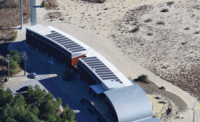Iowa Court & South Green Living Shoreline Project
Little Egg Harbor Township & Tuckerton Borough, N.J.
Best Project
Owner: Little Egg Harbor Township and Tuckerton Borough
Lead Design Firm | Construction Manager | Structural and Civil Engineer: T&M Associates
General Contractor: Albert Marine
Sediment Sampling and Testing | Hydrographic Services: Princeton Hydro
Research Consultant: Arthur Chew Consulting
Recreating the benefits of a natural shoreline is more complicated than it seems, but the Iowa Court and South Green Living Shoreline Project in Little Egg Harbor and Tuckerton, N.J., used innovative techniques to install new features to restore damage from Hurricane Sandy and protect from future storms.
The $1.4-million project started and finished in September 2019 with installation of vegetative plantings, low-profile rocks and shell reefs. That eclectic mix aimed to stem shoreline erosion and stabilize beaches, marshes and wildlife habitats from the risks of rising sea levels and flooding; protect nearby properties from wave damage; restore and support roadway infrastructure; and strengthen existing natural buffers and ecosystems.
The municipalities—which took direct hits from Sandy, with some areas completely eroded—needed the project to restore resilience. In addition to identifying optimal areas to locate work, the project team built storm surge barriers that also protect natural features and critical infrastructure along Iowa Court and South Green Street.
Unique design elements include a marsh sill at the 1977 tidelands claim line, internal sheeting to allow twice a day overflow, a spat-on-shells feature to create an oyster habitat, plantings and the restoration of an acre of marsh. At South Green Street, the team installed a 228-linear-ft stone breakwater, replenished the beach and added another spat-on-shells feature for oysters.
The project encountered several challenges during execution, including the need for delicate placement of the marsh sill and a breakwater due to state and federal restrictions on alignment and size. The team also added an upper waler to account for a surveying error that had led to instalation of the first 100 ft of sheeting 6 in. too low. The team quickly adjusted for the error and was able to finish the project on time.
Back to New York Region's Best Projects Display Innovation, Quality







